Conservation of Biodiversity Initiatives
-
Conservation of Biodiversity
-
Conservation of Biodiversity Initiatives
The Daihatsu Group promotes biodiversity conservation measures with deep roots in local communities and seeks to achieve harmony with nature. We also collaborate with local governments and residents to address biodiversity issues in their communities and work toward achieving solutions. To expand the scope of these activities by instilling an environmental mindset, we also conduct educational activities on biodiversity for employees and local communities.
Conservation Activities in the “Hagukumi no Mori Ryuoh” Company-owned Forest
Daihatsu is developing forests by making use of the regional characteristics at its company-owned forests in the Shiga area. We began development in 2019 with the objectives of conserving biodiversity and providing environmental education and hands-on experiences, and adopted the name “Hagukumi no Mori Ryuoh” in 2020 through an in-company suggestion program. We perform green space management including tree thinning and planting in satoyama forests so that these areas can become habitats for more diverse wildlife. We also monitor indicator species (organisms that can be used to gain an understanding of environmental conditions in areas such as forests, grasslands, and wetlands) with the aim of achieving harmony with nature.
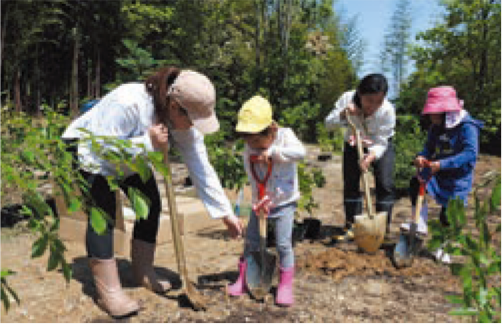 Tree-planting party
Tree-planting party
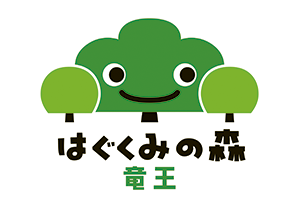
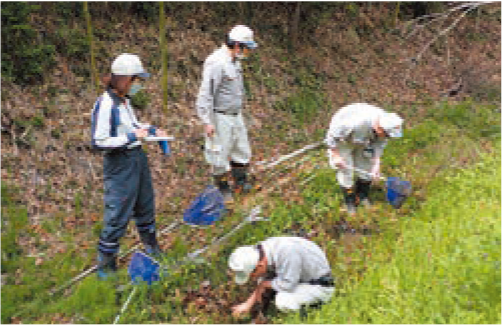 Surveys of indicator species
Surveys of indicator species
Ina River Cleanup Project
Daihatsu participates in the “Ina River Cleanup Project,” in which residents, companies, and government agencies that live or conduct business in the Ina River basin, which straddles Hyogo and Osaka Prefectures, clean up various areas in the basin. This initiative seeks to make the Ina River a clean waterway where diverse wildlife can live through the collaborative efforts of the public and private sectors. Two hundred and nine Daihatsu and affiliated company employees and family members participated in the “22nd Ina River Cleanup Project” conducted in February 2025 and worked alongside local residents to collect trash from the river banks. Participants emphasized the importance of continuing the activities over time, stating that they wanted to participate again in the future and that this sort of diligent honest effort is the most important kind.
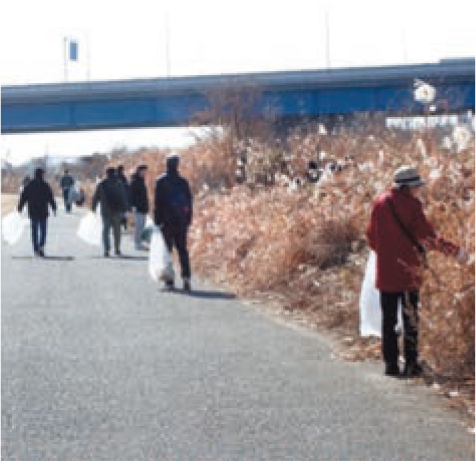 Participants in the Ikeda area
Participants in the Ikeda area
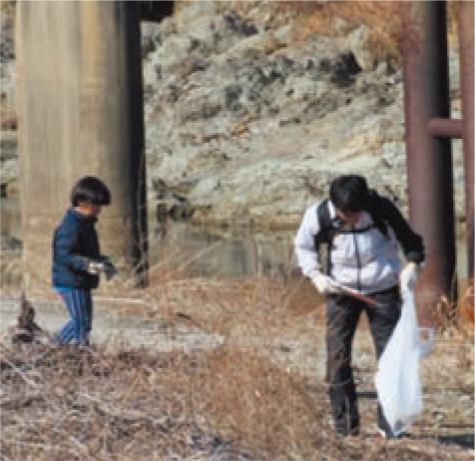 Participants in the Tada area
Participants in the Tada area
Preservation of Rare Species
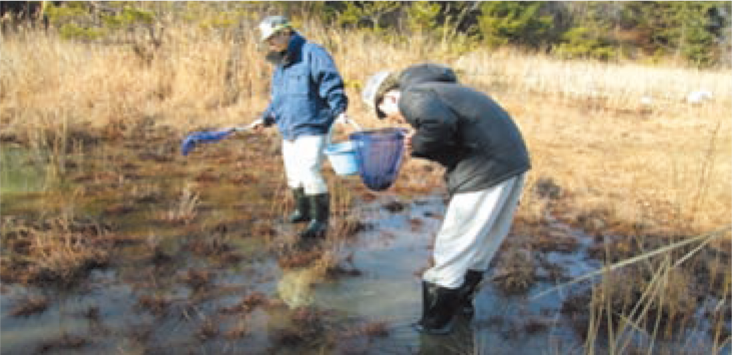 Exterminating conditionally designated invasive alien species (Red swamp crayfish; Procambarus clarkii)
Exterminating conditionally designated invasive alien species (Red swamp crayfish; Procambarus clarkii)
Daihatsu has been conducting wildlife surveys at its business sites and adjacent areas in Japan since 2015. We learned that these areas serve as habitats for a wide range of wildlife including numerous endangered and rare species that are on red lists compiled by the Ministry of the Environment and local governments of the prefectures in which our business sites operate. To protect these important organisms and establish habitats for even more diverse wildlife, we are undertaking preservation measures suitable for our business sites based on advice from experts.
The Hagukumi no Mori Biotope Area in Shiga includes habitats for the Japanese rice fish (medaka, Oryzias latipes; Ministry of the Environment: Near Threatened Species Category II), dragonfly (brachytron anisopterum, Ministry of the Environment: Near Threatened), and the hyacinth orchid (bletilla striata; Ministry of the Environment: Near Threatened). Since 2023, initiatives have been underway to exterminate conditionally designated invasive alien species for the purpose of conserving these rare species and their habitats.
Environmental Study at Shiga Prefectural Lake Biwa Museum
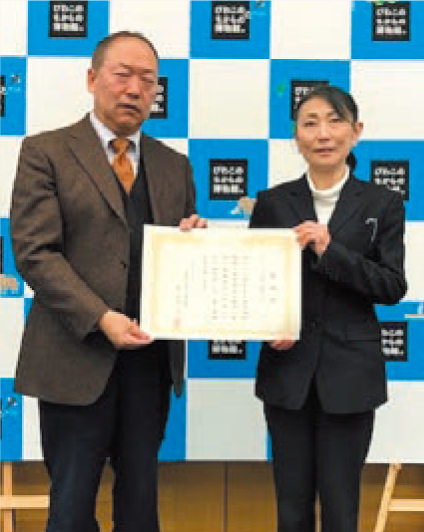 Thank-you letter for donations in support of rehabilitation of aquatic species exhibits
Thank-you letter for donations in support of rehabilitation of aquatic species exhibits
With cooperation from the Shiga Prefectural Lake Biwa Museum, Daihatsu conducts environmental programs for employees and family members each year. The purposes of these programs are to raise environmental awareness and develop human resources to support the creation of a society in harmony with nature and to contribute to the environmental education of the children who will become the leaders of the future. Through its philanthropic activities, Daihatsu is cooperating with the conservation of Lake Biwa’s thriving ecosystems. The Lake Biwa Museum offered support for these initiatives, and we are implementing various programs in collaboration with the museum.
Daihatsu also cooperated with donation activities in support of rehabilitation of aquatic species exhibits such as those conducted by the Lake Biwa Museum, including tunnel tank rehabilitation and the installation of a new tank for giant Lake Biwa catfish.
Daihatsu collaborates and cooperates with local governments and civic groups to undertake a wide range of activities at its main business sites including the Head (Ikeda) Plant and Kyoto (Oyamazaki) Plant to preserve and restore biodiversity.
Ebara River Cleanup Project (Head (Ikeda)Plant)
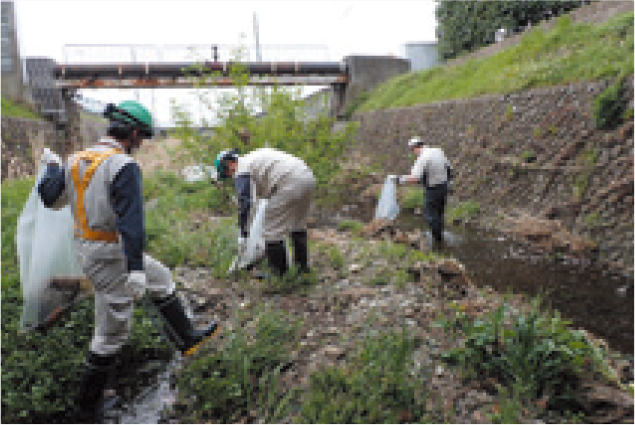 Cleanup work of the Ebara River, which flows through the plant grounds
Cleanup work of the Ebara River, which flows through the plant grounds
The Head (Ikeda) Plant works in collaboration with Ikeda City to implement the “Ebara River Cleanup Project activities” for the Ebara River, which flows through the plant grounds as a city-designated river*. Fresh-water sprats, loaches, Japanese mitten crabs, and other wildlife are known to inhabit the Ebara River, and there is a natural environment with abundant wildlife within the plant premises. This project intends to clean up trash that flows from upstream and protect the wildlife living in the river. Daihatsu will continue its efforts to protect regional ecosystems through these types of initiatives.
* This refers to a legally designated type of river (junyo-kasen) managed by the city
“Tree-planting Party” Conservation Activity (Head (Ikeda) Plant)
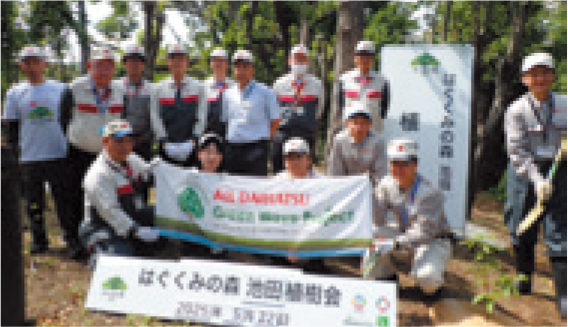 Hagukumi no Mori Ikeda Tree-planting Party
Hagukumi no Mori Ikeda Tree-planting Party
Employees at business sites engaged in forest conservation activities in the Ikeda area around the Head Plant, “collecting seeds from inside the business site in 2020, cultivating them, and then planting trees in 2025.” Based on these efforts, we held a “Tree-planting Party” on May 22, 2025, World Biodiversity Day. This served as an opportunity to foster an environmental mindset among employees while also contributing to rejuvenating local habitats.
Luciola Parvula Firefly Conservation Activity (Kyoto (Oyamazaki) Plant)
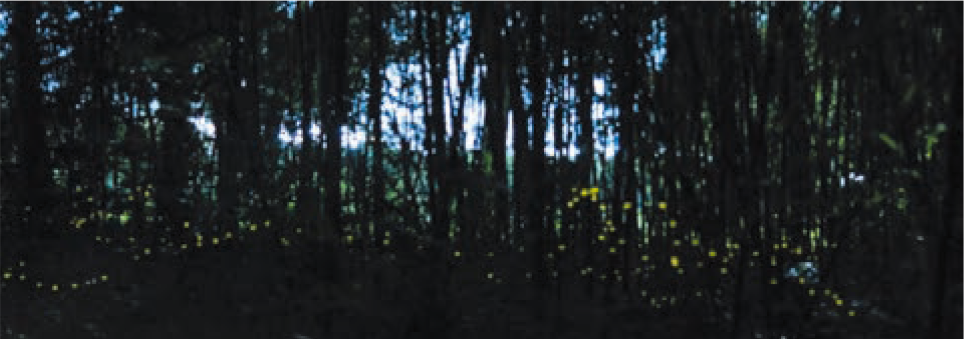 Luciola parvula fireflies flying through the forest
Luciola parvula fireflies flying through the forest
Wild fireflies (luciola parvula, Red Book in 17 prefectures) inhabit Yodogawa Riverside Park and the Katsura River basin located near the Kyoto (Oyamazaki) Plant. Daihatsu works to protect luciola parvula fireflies by cutting down overgrown bamboo forests in Yodogawa Riverside Park, chipping the bamboo, and spreading it across the forest floor. In the Katsura River basin, we participated in clean-up activities together with local residents to maintain the rich natural environment for luciola parvula fireflies to inhabit.
Conserving Edo Higan Cherry Tree Saplings (Tada Engineer Center)
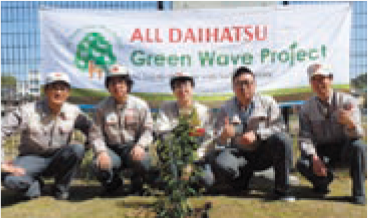
In the Tada area, Daihatsu germinates seeds and grows Edo Higan wild cherry tree saplings. The seeds are from the Suimeidai Edo Higan community, a natural monument of the city. The Tree-planting Party was held because these saplings grew. The Edo Higan community is a natural monument of Kawanishi City and has been designated as rank B in the Hyogo Prefecture Red Data Book. We also contribute to other natural conservation activities such as participating in the “Committee to Protect the Cherry Blossoms of the Valley,” a natural conservation group dedicated to protecting Edo Higan cherry trees in Kawanishi City, in addition to participating in environmental classes held at local Kawanishi City elementary schools to teach children about the importance of nature.
Exterminating the Invasive Canada Goldenrod (Nishinomiya Parts Center)
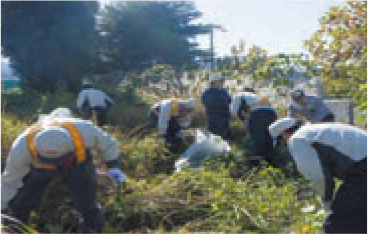
The Nishinomiya Parts Center is working to exterminate the specified invasive species Canadian goldenrod (solidago canadensis) from the center’s grounds. The spread of invasive species degrades biodiversity (destroys the habitats of existing species), so Daihatsu contributes to local habitat conservation efforts by exterminating invasive species. In fiscal 2025, we eliminated approximately 3,000 plants.
“WEB Environment Fair 2024,” Environment Booth Exhibit (Kyushu Development Center)
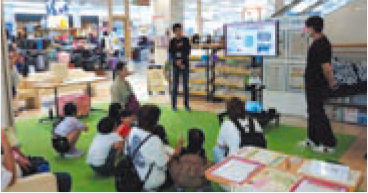 Daihatsu exhibit booth
Daihatsu exhibit booth
The Kyushu Development Center exhibited at the WEB Environment Fair 2024, which is held by Kurume City, Fukuoka Prefecture in collaboration with local companies and environmental organizations to encourage private citizens to start living in a more environmentally-conscious way. At the Daihatsu exhibit corner, we showcased Daihatsu’s environmental initiatives and presented environmental quizzes, attracting a total of 253 visitors over two days.
Daihatsu collaborates with a variety of parties including local governments, companies, and action groups to implement activities for achieving a society in harmony with nature. The contributions of Daihatsu’s activities to conserving biodiversity and raising public awareness have been recognized and praised in various quarters.
“Biodiversity Biwako Network” Dragonfly Conservation Activities
The “Biodiversity Biwako Network (BBN),” established by five* companies (including Daihatsu) based in Shiga Prefecture, conducts biodiversity conservation activities in Shiga on a continuous basis while enhancing effectiveness through collaboration.
In 2016, BBN launched a project called “100 Species Dragonflies Initiative—Save Dragonflies in Shiga!” This biodiversity conservation activity uses the 100 species of dragonflies confirmed to be present in the prefecture as indicator for the conservation health of the area. The three missions of the project are “Look for 100 species of dragonflies in Shiga!,” “Protect dragonflies in Shiga!,” and “Let everyone know!” The BBN conducts management and periodic monitoring of green spaces, wetlands, and ponds owned by member companies, determines the state of nature in surrounding areas, maintains biotopes, eliminates invasive species, holds nature observation tours, publicly announces their activities through exhibitions and presentations, and takes various other activities. In fiscal 2025, an additional new species of dragonfly was found (total of 89 species), and 108 actions were taken to protect the dragonflies. We also conducted PR activities that reached a total of 50,950 people through dragonfly study groups, watching clubs, academic conference presentations, and museum exhibits.
At the Shiga (Ryuoh) Plant’s “Hagukumi no Mori Biotope Area and Satoyama Woodland Area,” one of Shiga’s leading dragonfly habitats, we received a request for a tour of the site by the Japanese Society for Odonatology as a conservation technology training site. On the day of the tour, the Japanese Society for Odonatology personnel joined Biodiversity Biwako Network members for wide-ranging discussions and instruction, deepening interpersonal connections.
Daihatsu will continue to play a central role in the BBN and work to conserve biodiversity and achieve a sustainable society by implementing regional social contribution activities.
* Asahi Kasei Corporation, Asahi Kasei Homes Corporation, Sekisui Jushi Corporation, Daifuku Co., Ltd., and Daihatsu Motor Co., Ltd.
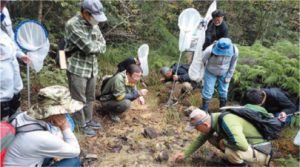 Scarlet dwarf dragonfly habitat/conservation candidate site search team with additional experts at Shiga Prefectural Kibougaoka Cultural Park
Scarlet dwarf dragonfly habitat/conservation candidate site search team with additional experts at Shiga Prefectural Kibougaoka Cultural Park
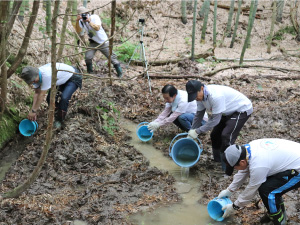 Digging in wetlands to preserve the habitats of Aeschnophlebia Anisoptera and other species of dragonflies
Digging in wetlands to preserve the habitats of Aeschnophlebia Anisoptera and other species of dragonflies
History of Awards, Certifications, and Other Accreditations
| March 2019 | Shiga Biodiversity Initiatives Certification in 2018 (certification renewed in 2021) The Shiga (Ryuoh) Plant was awarded three stars, the highest rank, by Shiga Prefecture under the “FY2019 Shiga Biodiversity Initiatives Certification” system. The Shiga (Ryuoh) Plant was recognized by Shiga Prefecture as a company that engages in biodiversity initiatives. The plant’s activities include thinning, tree-planting, proper mowing, and other green space management in satoyama forests, as well as a range of ongoing biodiversity conservation activities. |
|---|---|
| November 2019 | Jury Prize of the Biodiversity Action Award Japan 2019 Since 2018, the Shiga (Ryuoh) Plant has been participating in the “Biodiversity Biwako Network (BBN)” and taken part in activities that contribute to conserving biodiversity in Shiga Prefecture. The BBN comprises seven companies (at the time the prize was awarded) located in the prefecture and contributes to regional biodiversity conservation while expanding collaboration, such as through the “100 Species Dragonflies Initiative—Save Dragonflies in Shiga!,” a project that engages in the three missions regarding the 100 species of dragonflies found in the prefecture. |
| December 2019 | Osaka Environment Award Grand Prize Daihatsu was recognized for the clear direction and framework of its environmental initiatives, collaboration with a broad range of local parties, and conservation and educational programs rooted in local communities. |
| March 2021 | 2021 Japan Nature Conservation Grand Prize The “Biodiversity Biwako Network (BBN),” established by seven companies (at the time the prize was awarded) based in Shiga Prefecture, conducts biodiversity conservation activities using 100 species of dragonflies as indicator species. As a result of these efforts, the BBN was awarded the “2021 Japan Nature Conservation Grand Prize” in the education category by The Nature Conservation Society of Japan. |